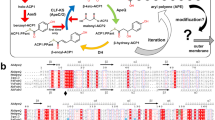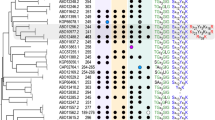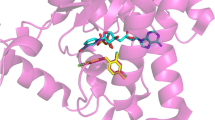Abstract
Klebsiella pneumoniae, a bacterial pathogen infamous for antibiotic resistance, is included in the priority list of pathogens by various public health organizations due to its extraordinary ability to develop multidrug resistance. Bacterial fatty acid biosynthesis pathway-II (FAS-II) has been considered a therapeutic drug target for antibacterial drug discovery. Inhibition of FAS-II enzyme, enoyl-acyl carrier protein reductase, FabI, not only inhibits bacterial infections but also reverses antibiotic resistance. Here, we characterized Klebsiella pneumoniae FabI (KpFabI) using complementary experimental approaches including, biochemical, x-ray crystallography, and molecular dynamics simulation studies. Biophysical studies shows that KpFabI organizes as a tetramer molecular assembly in solution as well as in the crystal structure. Enzyme kinetics studies reveal a distinct catalytic property towards crotonyl CoA and reducing cofactor NADH. Michaelis-Menten constant (Km) values of substrates show that KpFabI has higher preference towards NADH as compared to crotonyl CoA. The crystal structure of tetrameric apo KpFabI folds into a classic Rossman fold in which β-strands are sandwiched between α-helices. A highly flexible substrate binding region is located toward the interior of the tetrameric assembly. Thermal stability assay on KpFabI with its substrate shows that the flexibility is primarily stabilized by cofactor NADH. Moreover, the molecular dynamics further supports that KpFabI has highly flexible regions at the substrate binding site. Together, these findings provide evidence for highly dynamic substrate binding sites in KpFabI, therefore, this information will be vital for specific inhibitors discovery targeting Klebsiella pneumoniae.






Similar content being viewed by others
References
Podschun R, Ullmann U (1998) Klebsiella spp. as nosocomial pathogens: epidemiology, taxonomy, typing methods, and pathogenicity factors. Clin Microbiol Rev 11:589–603
World Health Organization (2014) Antimicrobial resistance: global report on surveillance. World Health Organization, Geneva
Logan LK, Nguyen DC, Huang FAS et al (2019) A multi-centered case-case-control study of factors associated with Klebsiella pneumoniae carbapenemase-producing Enterobacteriaceae Infections in children and young adults. Pediatr Infect Dis J 38:490
Holt KE, Wertheim H, Zadoks RN et al (2015) Genomic analysis of diversity, population structure, virulence, and antimicrobial resistance in Klebsiella pneumoniae, an urgent threat to public health. Proc Natl Acad Sci 112:E3574–E3581
Wang G, Zhao G, Chao X et al (2020) The characteristic of virulence, biofilm and antibiotic resistance of Klebsiella pneumoniae. Int J Environ Res Public Health 17:6278
Chang D, Sharma L, Dela Cruz CS, Zhang D (2021) Clinical epidemiology, risk factors, and control strategies of Klebsiella pneumoniae Infection. Front Microbiol 12:750662
Bassetti M, Righi E, Carnelutti A et al (2018) Multidrug-resistant Klebsiella pneumoniae: challenges for treatment, prevention and Infection control. Expert Rev Anti Infect Ther 16:749–761
Rock CO, Cronan JE (1996) Escherichia coli as a model for the regulation of dissociable (type II) fatty acid biosynthesis. Biochim Biophys Acta 1302:1–16
Kim HU (2020) Lipid metabolism in plants. Plants 9:871
Schweizer E, Hofmann J (2004) Microbial type I fatty acid synthases (FAS): major players in a network of cellular FAS systems. Microbiol Mol Biol Rev 68:501–517
Baldock C, de Boer G-J, Rafferty JB et al (1998) Mechanism of action of diazaborines. Biochem Pharmacol 55:1541–1549
Högenauer G, Woisetschläger M (1981) A diazaborine derivative inhibits lipopolysaccharide biosynthesis. Nature 293:662–664
Wright HT, Reynolds KA (2007) Antibacterial targets in fatty acid biosynthesis. Curr Opin Microbiol 10:447–453
Campbell JW, Cronan JE Jr (2001) Bacterial fatty acid biosynthesis: targets for antibacterial drug discovery. Annu Rev Microbiol 55:305–332
Hiltunen JK, Chen Z, Haapalainen AM et al (2010) Mitochondrial fatty acid synthesis–an adopted set of enzymes making a pathway of major importance for the cellular metabolism. Prog Lipid Res 49:27–45
Magnuson K, Jackowski S, Rock CO, Cronan JE Jr (1993) Regulation of fatty acid biosynthesis in Escherichia coli. Microbiol Rev 57:522–542
McMurry LM, Oethinger M, Levy SB (1998) Triclosan targets lipid synthesis. Nature 394:531–532
Quemard A, Sacchettini JC, Dessen A et al (1995) Enzymic characterization of the target for isoniazid in Mycobacterium tuberculosis. Biochemistry 34:8235–8241
Lu H, Tonge PJ (2008) Inhibitors of FabI, an enzyme drug target in the bacterial fatty acid biosynthesis pathway. Acc Chem Res 41:11–20
Yao J, Rock CO (2016) Resistance mechanisms and the future of bacterial enoyl-acyl carrier protein reductase (FabI) antibiotics. Cold Spring Harb Perspect Med 6:a027045
Jordan CA, Sandoval BA, Serobyan MV et al (2015) Crystallographic insights into the structure-activity relationships of diazaborine enoyl-ACP reductase inhibitors. Acta Cryst F71:1521–1530
Lee JH, Park AK, Chi YM, Jeong SW (2015) Crystal structures of Pseudomonas aeruginosa enoyl-ACP reductase (FabI) in the presence and absence of NAD + and Triclosan. Bull Korean Chem Soc 36:322–326
Kim HT, Kim S, Na BK et al (2017) Structural insights into the dimer-tetramer transition of FabI from Bacillus anthracis. Biochem Biophys Res Commun 493:28–33
Kim K-H, Ha BH, Kim SJ et al (2011) Crystal structures of enoyl-ACP reductases I (FabI) and III (FabL) from B. subtilis. J Mol Biol 406:403–415
Sivaraman S, Zwahlen J, Bell AF et al (2003) Structure – activity studies of the inhibition of FabI, the enoyl reductase from Escherichia coli, by Triclosan: kinetic analysis of mutant FabIs. Biochemistry 42:4406–4413
Oppermann U, Filling C, Hult M et al (2003) Short-chain dehydrogenases/reductases (SDR): the 2002 update. Chem Biol Interact 143–144:247–253
White SW, Zheng J, Zhang Y-M, Rock CO (2005) The structural biology of type II fatty acid biosynthesis. Annu Rev Biochem 74:791–831
Chen Z-J, Pudas R, Sharma S et al (2008) Structural enzymological studies of 2-enoyl thioester reductase of the human mitochondrial FAS II pathway: new insights into its substrate recognition properties. J Mol Biol 379:830–844
Bergler H, Wallner P, Ebeling A et al (1994) Protein EnvM is the NADH-dependent enoyl-ACP reductase (FabI) of Escherichia coli. J Biol Chem 269:5493–5496
Liu N, Cummings JE, England K et al (2011) Mechanism and inhibition of the FabI enoyl-ACP reductase from Burkholderia pseudomallei. J Antimicrob Chemother 66:564–573
Consortium TU (2022) UniProt: the Universal protein knowledgebase in 2023. Nucleic Acids Res 51:D523–D531
Tamura K, Stecher G, Kumar S (2021) MEGA11: molecular evolutionary genetics analysis version 11. Mol Biol Evol 38:3022–3027
Felsenstein J (1981) Evolutionary trees from DNA sequences: a maximum likelihood approach. J Mol Evol 17:368–376
Letunic I, Bork P (2021) Interactive tree of life (iTOL) v5: an online tool for phylogenetic tree display and annotation. Nucleic Acids Res 49:W293–W296
Sayers EW, Bolton EE, Brister JR et al (2022) Database resources of the national center for biotechnology information. Nucleic Acids Res 50:D20–D26
Vonrhein C, Flensburg C, Keller P et al (2011) Data processing and analysis with the autoPROC toolbox. Acta Cryst D67:293–302
Kabsch W (2010) XDS Acta Cryst D66:125–132
Evans PR, Murshudov GN (2013) How good are my data and what is the resolution? Acta Cryst D69:1204–1214
Long F, Vagin AA, Young P, Murshudov GN (2008) BALBES: a molecular-replacement pipeline. Acta Cryst D64:125–132
Agirre J, Atanasova M, Bagdonas H et al (2023) The CCP4 suite: integrative software for macromolecular crystallography. Acta Cryst D79:449–461
Murshudov GN, Skubak P, Lebedev AA et al (2011) REFMAC5 for the refinement of macromolecular crystal structures. Acta Cryst D67:355–367
Emsley P, Cowtan K (2004) Coot: model-building tools for molecular graphics. Acta Cryst D60:2126–2132
Kovalevskiy O, Nicholls RA, Murshudov GN (2016) Automated refinement of macromolecular structures at low resolution using prior information. Acta Cryst D72:1149–1161
Jorgensen WL, Chandrasekhar J, Madura JD et al (1983) Comparison of simple potential functions for simulating liquid water. J Chem Phys 79:926–935
Kantardjieff KA, Rupp B (2003) Matthews coefficient probabilities: improved estimates for unit cell contents of proteins, DNA, and protein-nucleic acid complex crystals. Protein Sci 12:1865–1871
Krissinel E, Henrick K (2007) Inference of macromolecular assemblies from crystalline state. J Mol Biol 372:774–797
Li Y, Kumar S, Zhang L et al (2022) Klebsiella Pneumonia and its antibiotic resistance: a bibliometric analysis. Biomed Res Int 2022:1668789
Munita JM, Arias CA (2016) Mechanisms of antibiotic resistance. Microbiol Spectr 4:10
Parker EN, Cain BN, Hajian B et al (2022) An iterative approach guides discovery of the FabI inhibitor Fabimycin, a late-stage antibiotic candidate with in vivo efficacy against drug-resistant Gram-negative Infections. ACS Cent Sci 8:1145–1158
Carfrae LA, Rachwalski K, French S et al (2023) Inhibiting fatty acid synthesis overcomes colistin resistance. Nat Microbiol 8:1026–1038
Rana P, Ghouse SM, Akunuri R et al (2020) FabI (enoyl acyl carrier protein reductase) - a potential broad spectrum therapeutic target and its inhibitors. Eur J Med Chem 208:112757
Karlowsky JA, Laing NM, Baudry T et al (2007) In vitro activity of API-1252, a novel FabI inhibitor, against clinical isolates of Staphylococcus aureus and Staphylococcus epidermidis. Antimicrob Agents Chemother 51:1580–1581
Parker EN, Drown BS, Geddes EJ et al (2020) Implementation of permeation rules leads to a FabI inhibitor with activity against Gram-negative pathogens. Nat Microbiol 5:67–75
Rafi S, Novichenok P, Kolappan S et al (2006) Structure of acyl carrier protein bound to FabI, the FASII enoyl reductase from Escherichia coli. J Biol Chem 281:39285–39293
Joyner PM, Tran DP, Zenaidee MA, Loo JA (2022) Characterization of protein–ligand binding interactions of enoyl-ACP reductase (FabI) by native MS reveals allosteric effects of coenzymes and the inhibitor triclosan. Protein Sci 31:568–579
Marcinkeviciene J, Jiang W, Kopcho LM et al (2001) Enoyl-ACP reductase (FabI) of Haemophilus influenzae: steady-state kinetic mechanism and inhibition by Triclosan and Hexachlorophene. Arch Biochem Biophys 390:101–108
Min J, Zhang X, Wang L et al (2011) Mutational analysis of the interaction between a potential inhibitor luteolin and enoyl-ACP reductase (FabI) from Salmonella enterica. J Mol Catal B Enzym 68:174–180
Kim SJ, Ha BH, Kim KH et al (2010) Dimeric and tetrameric forms of enoyl-acyl carrier protein reductase from Bacillus cereus. Biochem Biophys Res Commun 400:517–522
Lu H, England K, am Ende C et al (2009) Slow-onset inhibition of the FabI enoyl reductase from Francisella tularensis: residence time and in vivo activity. ACS Chem Biol 4:221–231
Otero JM, Noel A-J, Guardado-Calvo P et al (2012) High-resolution structures of Thermus thermophilus enoyl-acyl carrier protein reductase in the apo form, in complex with NAD + and in complex with NAD + and triclosan. Acta Cryst F68:1139–1148
Baugh L, Gallagher LA, Patrapuvich R et al (2013) Combining functional and structural genomics to sample the essential Burkholderia structome. PLoS ONE 8:e53851
Priyadarshi A, Kim EE, Hwang KY (2010) Structural insights into Staphylococcus aureus enoyl-ACP reductase (FabI), in complex with NADP and triclosan. Proteins: Struct Funct Bioinf 78:480–486
Hollingsworth SA, Dror RO (2018) Molecular dynamics simulation for all. Neuron 99:1129–1143
Acknowledgements
Soumya Biswas is supported by the Bayer MEDHA Fellowship Program of Bayer India Foundation. Anupam Patra is recipient of Council of Scientific and Industrial Research- Senior Research Fellowship (CSIR-SRF). Gajraj Singh Kushwaha is supported by Indian Council of Medical Research (ICMR) Research Associate Award number BMI/11(45)/2020. We acknowledge Department of Biotechnology (DBT), Government of India (BT/INF/22/SP22660/2017) for ESRF Access Program for x-ray data collection. We acknowledge infrastructure support available through DBT-BUILDER program (BT/INF/22/SP42155/2021) at KIIT University.
Author information
Authors and Affiliations
Contributions
Soumya Biswas- Methodology, Investigation, Analysis, Data Curation, Validation, Writing - Original Draft, Anupam Patra- Investigation, Analysis, Data Curation, Validation, Prajita Paul- Investigation, Analysis, Data Curation, Validation, Namrata Misra- Analysis, Data Curation, Review & Editing Gajraj Singh Kushwaha- Conceptualization, Methodology, Validation, Supervision, Writing - Original Draft, Review & Editing, Mrutyunjay Suar- Supervision, Resources, Writing - Review & Editing, Project administration, Funding acquisition.
Corresponding authors
Ethics declarations
Conflict of interest
A patent application on KpFabI has been filed to Indian Patent office by Kalinga Institute of Industrial Technology (KIIT) Deemed to be University, Bhubaneswar.
Additional information
Publisher’s Note
Springer Nature remains neutral with regard to jurisdictional claims in published maps and institutional affiliations.
Electronic Supplementary Material
Below is the link to the electronic supplementary material.
Rights and permissions
Springer Nature or its licensor (e.g. a society or other partner) holds exclusive rights to this article under a publishing agreement with the author(s) or other rightsholder(s); author self-archiving of the accepted manuscript version of this article is solely governed by the terms of such publishing agreement and applicable law.
About this article
Cite this article
Biswas, S., Patra, A., Paul, P. et al. Structural and Biochemical Studies on Klebsiella Pneumoniae Enoyl-ACP Reductase (FabI) Suggest Flexible Substrate Binding Site. Protein J 43, 84–95 (2024). https://doi.org/10.1007/s10930-023-10176-8
Accepted:
Published:
Issue Date:
DOI: https://doi.org/10.1007/s10930-023-10176-8




